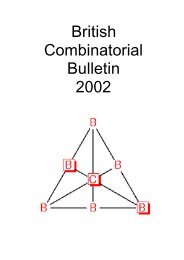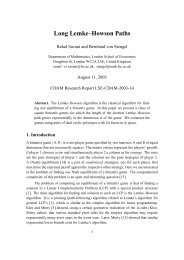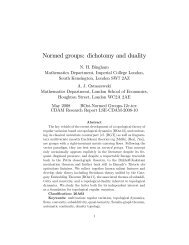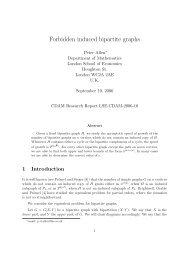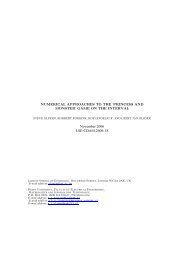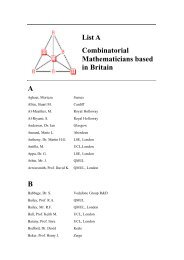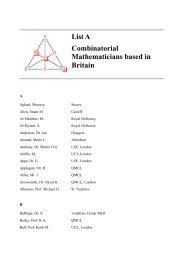Abstracts - London School of Economics and Political Science
Abstracts - London School of Economics and Political Science
Abstracts - London School of Economics and Political Science
You also want an ePaper? Increase the reach of your titles
YUMPU automatically turns print PDFs into web optimized ePapers that Google loves.
Queen Mary, University <strong>of</strong> <strong>London</strong><br />
The <strong>London</strong> <strong>School</strong> <strong>of</strong> <strong>Economics</strong> <strong>and</strong><br />
<strong>Political</strong> <strong>Science</strong><br />
One Day Colloquia in<br />
Combinatorics<br />
20 th & 21 st May 2009
WEDNESDAY 20 th MAY 2009<br />
The first <strong>of</strong> the two linked colloquia in combinatorics will be held at Queen<br />
Mary, University <strong>of</strong> <strong>London</strong> on Wednesday 20 th May, starting at 10.40.<br />
Everyone interested is welcome to attend any part <strong>of</strong> the event. All the talks<br />
will be held in the Maths Lecture Theatre (MLT), which can be found in the<br />
<strong>School</strong> <strong>of</strong> Mathematical <strong>Science</strong>s.<br />
10.00 - 10.30 C<strong>of</strong>fee available for early arrivals in Room 102<br />
10.40 - 11.20 C. Elsholtz (Royal Holloway)<br />
11.25 - 12.05 A. Scott (Oxford)<br />
Problems in multidimensional additive combinatorics<br />
Triangles in r<strong>and</strong>om graphs<br />
12.05 - 13.30 Lunch (own arrangements - options on campus<br />
<strong>and</strong> nearby)<br />
13.30 - 14.10 D. Ellis (Cambridge)<br />
Combinatorial problems on the symmetric group:<br />
some applications <strong>of</strong> non-Abelian Fourier Analysis<br />
14.15 - 14.55 R. Morris (Cambridge)<br />
Some recent developments in bootstrap percolation<br />
14.55 - 15.35 C<strong>of</strong>fee break – Room 102<br />
15.35 - 16.15 L. Kelly (Birmingham)<br />
Arbitrary orientations <strong>of</strong> cycles in oriented graphs<br />
16.20 - 17.00 M. Walters (Queen Mary)<br />
Hamilton cycles in r<strong>and</strong>om geometric graphs<br />
Support for this event by the <strong>London</strong> Mathematical Society <strong>and</strong> the British<br />
Combinatorial Committee is gratefully acknowledged.
Multidimensional problems in additive combinatorics<br />
Christian Elsholtz<br />
We discuss bounds on extremal sets for problems like those below:<br />
1. What is the largest subset <strong>of</strong> (Z/nZ) r that does not contain an arithmetic<br />
progression <strong>of</strong> length k?<br />
2. What is the largest subset/(multiset) <strong>of</strong> (Z/nZ) r that does not contain<br />
n elements that sum to 0?<br />
3. What is the largest subset <strong>of</strong> [1, . . . , n] r that does not contain a solution<br />
<strong>of</strong> x + y = z (i.e., which is a sum free set)?<br />
4. Colour the elements <strong>of</strong> [1, . . . , n] r red <strong>and</strong> blue. How many monochromatic<br />
Schur triples are there?<br />
——————————<br />
Triangles in r<strong>and</strong>om graphs<br />
Alex Scott<br />
Let X be the number <strong>of</strong> triangles in a r<strong>and</strong>om graph G(n, 1/2). Loebl,<br />
Matousek <strong>and</strong> Pangrac showed that X is close to uniformly distributed modulo<br />
q when q = O(log n) is prime. We extend this result considerably, <strong>and</strong><br />
discuss further implications <strong>of</strong> our methods for the distribution <strong>of</strong> X. This<br />
is joint work with Atsushi Tateno (Oxford).<br />
1
Combinatorial problems on the symmetric group:<br />
some applications <strong>of</strong> non-Abelian Fourier Analysis<br />
David Ellis<br />
We say a family <strong>of</strong> permutations A ⊂ S n is t-intersecting if any two<br />
permutations in A agree in at least t places, i.e. for any σ, π ∈ A, |{i ∈ [n] :<br />
σ(i) = π(i)}| ≥ t. In 1977, Deza <strong>and</strong> Frankl proved that a 1-intersecting<br />
family has size at most (n − 1)!, <strong>and</strong> conjectured that if n is sufficiently large<br />
depending on t, a t-intersecting family A ⊂ S n has size at most (n−t)!. This<br />
was proved independently by the author <strong>and</strong> by Ehud Friedgut <strong>and</strong> Haran<br />
Pilpel in 2008, using the same techniques; we have recently submitted a joint<br />
paper. I will give a sketch <strong>of</strong> the pro<strong>of</strong>, which uses an eigenvalue argument<br />
combined with representation theory <strong>of</strong> S n .<br />
We will then turn to the question <strong>of</strong> stability. In 2003, Cameron <strong>and</strong> Ku<br />
conjectured that for n ≥ 6, a 1-intersecting family not contained within a<br />
coset <strong>of</strong> the stabilizer <strong>of</strong> a point cannot be larger than the family<br />
{σ ∈ S n : σ(1) = 1, σ(i) = i for some i > 2} ∪ {(12)}<br />
which has size (1 − 1/e + o(1))(n − 1)!, <strong>and</strong> that the extremal families are<br />
precisely the double cosets <strong>of</strong> this family. A generalization <strong>of</strong> this was proved<br />
by the author in 2008 using non-Abelian Fourier Analysis combined with a<br />
combinatorial argument: namely, for n sufficiently large depending on t, if<br />
A ⊂ S n is a t-intersecting family which is not contained within a coset <strong>of</strong> the<br />
stabilizer <strong>of</strong> t points, then A cannot be larger than the family<br />
{σ : σ(i) = i ∀i ≤ t, σ(j) = j for some j > t + 1} ∪ {(1 t + 1), . . . , (t t + 1)}<br />
which has size (1 − 1/e + o(1))(n − t)!; the extremal families are precisely the<br />
double cosets <strong>of</strong> this family. This can be seen as an analogue for permutations<br />
<strong>of</strong> the Hilton-Milner theorem on non-trivial intersecting families <strong>of</strong> r-sets. I<br />
will sketch the main ideas <strong>of</strong> the pro<strong>of</strong> in the t = 1 case.<br />
If time permits, we will then discuss some related questions.<br />
2
Some recent developments in bootstrap percolation<br />
Rob Morris<br />
Let G be a graph, r be an integer <strong>and</strong> A ⊂ V (G) be a set <strong>of</strong> ‘infected’<br />
vertices. The infection spreads according to the following rule: if a healthy<br />
site has at least r infected neighbours then it becomes infected, <strong>and</strong> infected<br />
sites are infected forever. Suppose the elements <strong>of</strong> A are chosen independently<br />
at r<strong>and</strong>om with probability p. At what point does percolation (infection <strong>of</strong><br />
the entire vertex set) become likely?<br />
I shall present some recent progress on this problem (known as bootstrap<br />
percolation) for the graph G = [n] d , <strong>and</strong> also discuss several open questions.<br />
In particular, we still know very little about what happens when the number<br />
<strong>of</strong> dimensions d = d(n) → ∞.<br />
(This is mostly joint work with Jozsi Balogh <strong>and</strong> Béla Bollobás, <strong>and</strong>/or<br />
some subset <strong>of</strong> Daniel Ahlberg, Tom Coker, Hugo Duminil-Copin, Janko<br />
Gravner <strong>and</strong> Ander Holroyd.)<br />
——————————<br />
Arbitrary orientations <strong>of</strong> cycles in oriented graphs<br />
Luke Kelly<br />
An oriented graph is a simple graph in which each edge is assigned a direction.<br />
Sufficient conditions for Hamilton cycles in oriented graphs have been much<br />
studied in the last few years. This has included the confirmation <strong>of</strong> an<br />
old conjecture <strong>of</strong> Häggkvist by Keevash, Kühn <strong>and</strong> Osthus, who proved that<br />
every large oriented graph G with minimum in-degree <strong>and</strong> out-degree at least<br />
(3|G| − 4)/8 contains a Hamilton cycle. In this talk I will present a recent<br />
result showing that, up to a linear error term, this minimum in-degree <strong>and</strong><br />
out-degree condition gives not just a Hamilton cycle but any orientation <strong>of</strong> a<br />
Hamilton cycle. This answers a conjecture from the 1997 paper <strong>of</strong> Häggkvist<br />
<strong>and</strong> Thomason in which they proved that a minimum in-degree <strong>and</strong> outdegree<br />
<strong>of</strong> 5|G|/12 suffices <strong>and</strong> conjectured that 3|G|/8 was the correct bound<br />
(both up to a linear error term ɛ|G|). I will also discuss results <strong>and</strong> open<br />
problems for arbitrary orientations <strong>of</strong> short cycles, where we need different<br />
conditions for different orientations.<br />
3
Hamilton cycles in r<strong>and</strong>om geometric graphs<br />
Mark Walters<br />
The Gilbert model <strong>of</strong> a r<strong>and</strong>om geometric graph is the following: place<br />
points at r<strong>and</strong>om in a (two-dimensional) square box <strong>and</strong> join two if they<br />
are within distance r <strong>of</strong> each other. For any st<strong>and</strong>ard graph property (e.g.<br />
connectedness) we can ask whether the graph is likely to have this property.<br />
If the property is monotone we can view the model as a process where we<br />
place our points <strong>and</strong> then increase r until the property appears.<br />
In this talk we consider the property that the graph has a Hamilton cycle.<br />
It is obvious that a necessary condition for the existence <strong>of</strong> a Hamilton cycle<br />
is that the graph be 2-connected. We prove that, for asymptotically almost<br />
all collections <strong>of</strong> points, this is a sufficient condition: that is, the smallest r<br />
for which the graph has a Hamilton cycle is exactly the smallest r for which<br />
the graph is 2-connected.<br />
This work is joint work with József Balogh <strong>and</strong> Béla Bollobás.<br />
4
The early evolution <strong>of</strong> the H-free process<br />
Peter Keevash<br />
The H-free process, for some fixed graph H, is the r<strong>and</strong>om graph process<br />
defined by starting with an empty graph on n vertices <strong>and</strong> then adding edges<br />
one at a time, chosen uniformly at r<strong>and</strong>om subject to the constraint that no<br />
H subgraph is formed. Let G be the r<strong>and</strong>om maximal H-free graph obtained<br />
at the end <strong>of</strong> the process. When H is strictly 2-balanced, we show that for<br />
some c > 0, with high probability as n → ∞, the minimum degree in G is<br />
at least cn 1−(v H−2)/(e H −1) (log n) 1/(e H−1) . This gives new lower bounds for the<br />
Turán numbers <strong>of</strong> certain bipartite graphs, such as the complete bipartite<br />
graphs K r,r with r ≥ 5. When H is a complete graph K s with s ≥ 5 we show<br />
that for some C > 0, with high probability the independence number <strong>of</strong> G is<br />
at most Cn 2/(s+1) (log n) 1−1/(e H−1) . This gives new lower bounds for Ramsey<br />
numbers R(s, t) for fixed s ≥ 5 <strong>and</strong> t large. We also obtain new bounds for<br />
the independence number <strong>of</strong> G for other graphs H, including the case when<br />
H is a cycle. Our pro<strong>of</strong>s use the differential equations method for r<strong>and</strong>om<br />
graph processes to analyse the evolution <strong>of</strong> the process, <strong>and</strong> also give further<br />
interesting information about the structure <strong>of</strong> the graphs obtained, including<br />
asymptotic formulae for a broad class <strong>of</strong> extension variables. This is joint<br />
work with Tom Bohman.<br />
——————————<br />
R<strong>and</strong>om intersection graphs<br />
Stefanie Gerke<br />
A uniform r<strong>and</strong>om intersection graph G(n, m, k) is a r<strong>and</strong>om graph constructed<br />
as follows. Label each <strong>of</strong> n nodes by a r<strong>and</strong>omly chosen set <strong>of</strong><br />
k distinct colours taken from some finite set <strong>of</strong> possible colours <strong>of</strong> size m.<br />
Nodes are joined by an edge if <strong>and</strong> only if some colour appears in both their<br />
labels. These graphs arise in the study <strong>of</strong> the security <strong>of</strong> wireless sensor networks.<br />
Such graphs arise in particular when modelling the network graph <strong>of</strong><br />
the well known key predistribution technique due to Eschenauer <strong>and</strong> Gligor.<br />
In this talk we discuss some basic properties <strong>of</strong> r<strong>and</strong>om intersection<br />
graphs, for example connectivity <strong>and</strong> the emergence <strong>of</strong> the giant component.<br />
This is joint wok with Simon Blackburn <strong>and</strong> Paul Balister.<br />
5
Synchrony <strong>and</strong> Asynchrony in Neural Networks<br />
Angelika Steger<br />
In this paper we pick up on a model described recently by DeVille <strong>and</strong><br />
Peskin (Bulletin <strong>of</strong> Mathematical Biology, to appear) for a stochastic pulsecoupled<br />
neural network. The key feature <strong>and</strong> novelty in their approach is<br />
that they describe the interactions <strong>of</strong> a neuronal system as a discrete-state<br />
stochastic dynamical network. They show (experimentally <strong>and</strong> by some estimates<br />
in an associated mean-field limit <strong>of</strong> the model) that their network can<br />
exhibit both synchronous <strong>and</strong> asynchronous behavior. They also exhibit a<br />
range <strong>of</strong> parameters for which the network switches seemingly spontaneously<br />
between synchrony <strong>and</strong> asynchrony. In synchronous behavior the firing <strong>of</strong><br />
one neuron leads to the firing <strong>of</strong> other neurons, which in turn may set <strong>of</strong>f<br />
a chain reaction that <strong>of</strong>ten involves a substantial proportion <strong>of</strong> the neurons.<br />
There are strong analogies to the giant component phenomenon in r<strong>and</strong>om<br />
graph theory.<br />
In this talk we present a rigorous analysis <strong>of</strong> the model <strong>of</strong> DeVille <strong>and</strong> Peskin,<br />
thereby answering in particular their questions about the actual parameter<br />
settings resp. thresholds for which these changes between synchronous<br />
<strong>and</strong> asynchronous behavior occur. We also provide insights into the coexistence<br />
<strong>of</strong> synchronous <strong>and</strong> asynchronous behavior <strong>and</strong> the conditions that<br />
trigger a “spontaneous” transition from one state to another.<br />
Joint work with Fabian Kuhn, Konstantinos Pangiotou, <strong>and</strong> Joel Spencer<br />
6
A Complexity Dichotomy for Hypergraph Partition Functions<br />
Leslie Ann Goldberg<br />
Abstract: The talk will introduce “partition functions”, which arise in<br />
many computational contexts, <strong>and</strong> will discuss the complexity <strong>of</strong> computing<br />
them. It will explain what a “dichotomy theorem” is, <strong>and</strong> why we want such<br />
theorems (essentially, we want them so that we can better underst<strong>and</strong> the<br />
boundary between the class <strong>of</strong> easy-to-compute functions <strong>and</strong> the class <strong>of</strong><br />
functions that cannot be efficiently computed).<br />
The particular technical problem which forms the foundation for the talk<br />
is the complexity <strong>of</strong> counting homomorphisms from an r-uniform hypergraph<br />
G to a symmetric r-ary relation H. We give a dichotomy theorem for r > 2,<br />
showing for which H this problem is easy to compute <strong>and</strong> for which H it<br />
is #P-complete. Our dichotomy theorem extends to the case in which the<br />
relation H is weighted, <strong>and</strong> the partition function to be computed is the sum<br />
<strong>of</strong> the weights <strong>of</strong> the homomorphisms. This problem is motivated by statistical<br />
physics, where it arises as computing the partition function for particle<br />
models in which certain combinations <strong>of</strong> r sites interact symmetrically.<br />
(joint work with Martin Dyer <strong>and</strong> Mark Jerrum)<br />
7
Wiretapping: the nucleolus <strong>of</strong> connectivity<br />
Rahul Savani<br />
We consider the problem <strong>of</strong> maximizing the probability <strong>of</strong> hitting a strategically<br />
chosen hidden network by placing a wiretap on a single link <strong>of</strong> a communication<br />
network. This can be seen as a two-player win-lose (zero-sum)<br />
game that we call the wiretap game. We also study this problem in a cooperative<br />
game setting. For the cooperative game we study, the connectivity<br />
game, we provide a polynomial-time algorithm for computing the nucleolus.<br />
The nucleolus <strong>of</strong> the connectivity game corresponds to a maxmin strategy<br />
in the wiretap game with desirable properties, for example, it minimizes the<br />
number <strong>of</strong> pure best responses <strong>of</strong> the player choosing the hidden network.<br />
The nucleolus <strong>of</strong> a connectivity game is also <strong>of</strong> interest as a mechanism for<br />
cost-sharing, where those links most likely to be used in connected spanning<br />
subgraphs are seen as most important or, alternatively, as most vulnerable.<br />
Joint work with Haris Aziz, Oded Lachish, <strong>and</strong> Mike Paterson<br />
——————————<br />
“The Norman Biggs Lecture”<br />
On the Category <strong>of</strong> Graphs<br />
Jaroslav Nešetřil<br />
We present a survey <strong>of</strong> categorical aspects <strong>of</strong> graph homomorphisms: constructions<br />
<strong>and</strong> global properties centered around notions <strong>of</strong> universality <strong>and</strong><br />
density.<br />
8
THURSDAY 21 st MAY 2009<br />
The second <strong>of</strong> the two linked colloquia in combinatorics will be held at the<br />
<strong>London</strong> <strong>School</strong> <strong>of</strong> <strong>Economics</strong> on Thursday 21 st May, starting at 10.00am.<br />
Everyone interested is welcome to attend any part <strong>of</strong> the event. The talks<br />
will be held in the New Theatre (E171), in the East Building.<br />
10.00 - 10.45 P. Keevash (Queen Mary)<br />
The early evolution <strong>of</strong> the H-free process<br />
10.45 - 11.05 C<strong>of</strong>fee break - E168<br />
11.05 - 11.50 S. Gerke (Royal Holloway)<br />
R<strong>and</strong>om intersection graphs<br />
11.55 - 12.40 A. Steger (ETH Zurich)<br />
Synchrony <strong>and</strong> asynchrony in neural networks<br />
12.40 - 14.05 Lunch (own arrangements - options on<br />
campus <strong>and</strong> nearby)<br />
14.05 - 14.50 L. Goldberg (Liverpool)<br />
A complexity dichotomy for hypergraph partition<br />
functions<br />
14.50 - 15.10 C<strong>of</strong>fee break – E168<br />
15.10 - 15.55 R. Savani (Warwick)<br />
Wiretapping: the nucleolus <strong>of</strong> connectivity<br />
16.00 - 17.00 “The Norman Biggs Lecture”<br />
J. Nešetřil (Prague)<br />
On the category <strong>of</strong> graphs<br />
Support for this event by the <strong>London</strong> Mathematical Society, the British<br />
Combinatorial Committee <strong>and</strong> an anonymous donor, is gratefully<br />
acknowledged.
Finding Your Way Around The LSE<br />
The number indicates both the floor <strong>and</strong> the room. Room<br />
numbers in the basement begin with a zero, numbers 1-99 are<br />
on the ground floor, 100-199 are on the first floor, 200-299 on<br />
the second floor <strong>and</strong> so on. Some rooms are identified by<br />
name rather than number.<br />
A – Old Building<br />
AH – Aldwych House<br />
B – Columbia House<br />
C – Clare Market Building<br />
D – Clement House<br />
E – East Building<br />
G – 20 Kingsway<br />
H – Connaught House<br />
I – Peacock Theatre<br />
J – Cowdray House<br />
K – King's Chambers<br />
L – Lincoln Chambers<br />
M – 50 Lincoln’s Inn Fields<br />
N – The Anchorage<br />
NAB – New Academic Building<br />
PH – Parish Hall<br />
PS – Portsmouth Street<br />
Q – Sheffield Street<br />
R – Lionel Robbins Building, LSE Library<br />
S – St Clement’s Building<br />
T – The Lakatos Building<br />
U , V, W – Tower One, Two, Three<br />
X – St Philips Building – Health Centre<br />
Y – St Philips Building – South Block<br />
Z – St Philips Building – North Block



